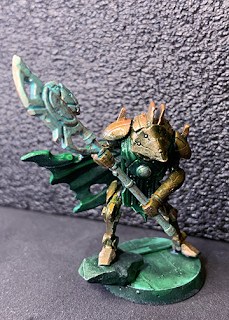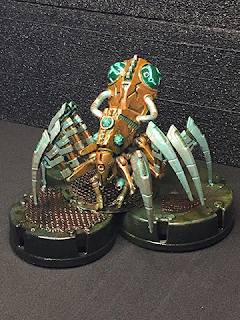Battle Report 03
I know this is a long time coming, but I have to be honest: I have put this battle off for as long as I have because I just don't like OPR's Eternal Dynasty line of figures. I get emotional about miniatures and the one emotion I have about the space samurai of the ED is frustration. There are so many small things that bother me about these figures that I couldn't bring myself to print, paint, and play them. In the meantime, I got ahold of another, similar army by The Hive that does what I want a printed army to do: give me options. These guys got printed and painted. I finally got armies on the table.
 |
| The wounded Infected Leader defends an Objective from both a Stealth Suit and a Grunt. |
Thus, the third skirmish of the Cruthanarc Campaign sees the Eternal Dynasty/Hive substitutes Count Blocken and the Cybermen, going up against CDF Squad Four of the Infected Colonies. Here are the point break-downs:
Count Blocken and the Cybermen
Stealth Suit [1] | Qua 4+ Def 4+ | 65pts
Weapons: Close Combat Weapon, Burst Carbine
Abilities: Ambush, Stealth, Tough (3)
Spotter [1] | Qua 5+ Def 5+ | 25pts
Weapons: Close Combat Weapon, Pulse Carbine
Abilities: Good Shot, Scout
Grunt [1] | Qua 5+ Def 4+ | 20pts
Weapons: Close Combat Weapon, Pulse Shotgun
Abilities: Good Shot
Grunt [1] | Qua 5+ Def 4+ | 20pts
Weapons: Close Combat Weapon, Pulse Shotgun
Abilities: Good Shot
Grunt [1] | Qua 5+ Def 4+ | 20pts
Weapons: Close Combat Weapon, Pulse Shotgun
Abilities: Good Shot
CDF Squad Four
Infected Leader [1] | Qua 5+ Def 5+ | 25pts
Weapons: Close Combat Weapon, Carbine
Abilities: Hero, Tough (3), Undead
Hunter [1] | Qua 3+ Def 4+ | 45pts
Weapons: Hardened Claws
Abilities: Ambush, Strider, Undead
Infected [3] | Qua 5+ Def 5+ | 35pts
Weapons: Close Combat Weapon, Carbine
Abilities: Undead
Infected Gunner [1] | Qua 5+ Def 5+ | 25pts
Weapons: Close Combat Weapon, Fusion Rifle
Abilities: Relentless, Undead
Infected Gunner [1] | Qua 5+ Def 5+ | 20pts
Weapons: Close Combat Weapon, Grenade Launcher
Abilities: Relentless, Undead
Note: The ability Undead is identical to Robot mechanically. Both alter the way morale works for these units. It indicates how dedicated these troops are, not how they are the walking dead.
This battle did not go as I imagined it would. The strength of the IC is melee and the strength of the Cybermen is their ranged weapons. I figured the battle would come down to how many Cybermen the IC Hunter could get close to. While he did take down one Cyberman, by the time the hunter withered under a hail of enemy fire, the battle was already decided. The surprising MVP of the battle was the lowly Infected Gunner with the grenade launcher. Despite needing a '6' virtually every time he took a shot, he hit three times in the three turns he had someone in range. As a consequence, the Cybermen presence in the middle of the board collapsed. By turn four, all the Cybermen could do was try to secure the secondary objective of knocking out the most expensive IC unit (the Hunter) and causing as many late-game casualties as possible (the Infected Gunner with a fusion rifle).
Mechanically, our MVP actually gets no XP for his roll in the battle. All of his hits stunned their targets and were subsequently knocked out by the Infected. This seems to me to be a bit of an injustice. Therefore I will rectify the situation by giving our Gunner a name. He will now be referred to as Amvish (the Accurate). Let us see if the campaign allows him to live up to the moniker...
 |
| Amvish casually waiting for another opportunity to blow something up. |
The post-battle Casualty Checks resulted in no deaths, but the Spotter for the Cybermen did gain a +1 XP.
Results:
Count Blocken and the Cybermen 0 VP and 40pts; +2 XP for the Stealth Suit, one Grunt, and the Spotter, +1 XP for the other Grunts
CDF Squad Four 1 VP and 10pts; +3 XP for the Infected, +2 XP for the Hunter, and +1 XP for everyone else.
As a final note, I really love how random events in the middle of a game reveal a story. The only reason I included the Infected Gunner on the IC list was to add a little needed range, not thinking it would ever amount to much. Little did I know...








